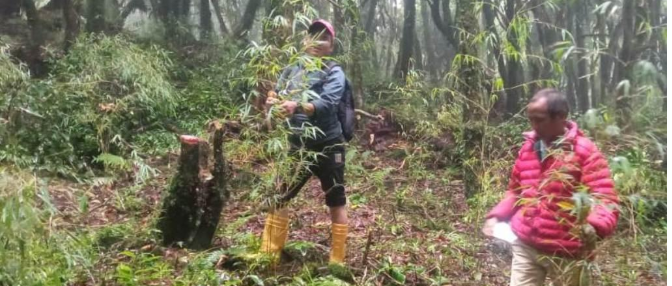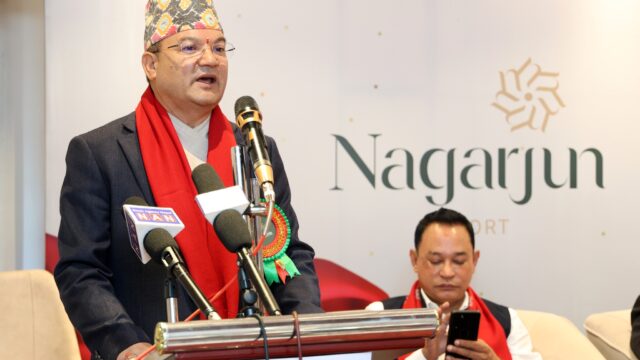Conservation Efforts Initiated to Protect Endangered Red Pandas
In an encouraging step towards wildlife preservation, Bhojpur district in eastern Nepal has commenced a dedicated conservation campaign targeting the endangered red panda (locally known as “Habre”). The initiative is being implemented by identifying key habitats within community forests, with support from the Red Panda Network, local authorities, and forest users’ groups.
The conservation efforts are currently focused in Temkemaiyung Rural Municipality–1, specifically within Bhuru Khek and Mahabhir Walbani Community Forests, where they have been previously sighted. According to Kapildev Adhikari, an official from the Division Forest Office, Bhojpur, a total of 8,000 malingo (bamboo) saplings, a primary food source for red pandas, have been planted to support the species’ dietary needs.

Camera Traps Deployed to Monitor their Movement
To understand the behavior and population status of red pandas in the region, 48 camera traps have been installed across four key community forests, including Naya Kharka, Bhurukhek, Dhappare Ekrate, and Maiyung. These forests lie along the scenic Mundhum Trail, a trekking route rich in biodiversity and cultural heritage.
The Red Panda Network has confirmed that cameras in Dhappare Ekrate Community Forest have successfully captured images of red pandas, indicating active habitation. Conservationists consider this a positive sign that supports the continuation and expansion of the project.

Anti-Poaching and Habitat Protection Measures
Red pandas are listed as a protected species under Nepal’s National Parks and Wildlife Conservation Act, 2029 BS, which imposes strict penalties for poaching and trafficking. Violators face fines between NPR 100,000 and 500,000, imprisonment ranging from one to ten years, or both.
To enforce these regulations, seven mobile anti-poaching patrol teams have been formed from local volunteers who have undergone wildlife monitoring training. These groups regularly patrol the forested zones to deter illegal activities and monitor the health of the ecosystem. Two dedicated forest guardians have also been appointed with monthly stipends, tasked with overseeing surveillance and reporting on sightings and threats.
According to Ganesh Shrestha, Chairperson of Samuhik Abhiyan Bhojpur, these efforts aim not only to protect red pandas but also to engage the local community in long-term conservation. “By installing cameras, conducting awareness programs, and deploying community patrols, we are working to ensure that the red panda is safe from poaching and illegal wildlife trade,” said Shrestha.
Community Involvement and Sustainable Livelihood Development
Community engagement has been central to the success of this conservation initiative. Last fiscal year, around NPR 1.33 million was mobilized, including voluntary labor, for pond construction and bamboo plantation, both of which are essential to creating a favorable habitat for red pandas and other wildlife.
In addition to ecological restoration, training programs in fire prevention and sustainable livelihood options have been introduced. These include feasibility studies on income-generating activities that align with conservation goals. The idea is to create a sustainable conservation model that also improves the socio-economic well-being of local residents.
“The residents are playing a proactive role,” added Chairperson Shrestha. “They are not only guardians of the forest but now part of a broader ecological mission that benefits biodiversity and future generations alike.”
Linking Red Panda Conservation with Eco-Tourism Potential
The conservation is also being viewed through the lens of eco-tourism development. Given that the red panda habitat falls along the Mundhum Trail, the region has untapped potential to attract domestic and international eco-tourists. By protecting the natural habitat of the red panda, stakeholders envision a tourism model that is both sustainable and educational.
According to Rama Devi Rai, Vice-Chairperson of Temkemaiyung Rural Municipality, plans are being laid to link conservation with local tourism, creating opportunities for guided wildlife treks, conservation awareness tours, and community homestays.
“This unique blend of biodiversity and indigenous culture has the power to transform the local economy,” said Rai. “We are committed to protecting this endangered species while also generating income through responsible tourism.”

Collaborative Approach Towards Conservation Success
Saroj Basnet, Chairperson of Temkemaiyung Rural Municipality, affirmed the local government’s commitment to red panda conservation. “We are working in coordination with multiple organizations to promote their conservation,” he said. “Our long-term goal is to develop red panda habitats into officially recognized Red Panda Zones, which will receive priority funding, scientific research, and eco-tourism branding.” He emphasized that conservation is a shared responsibility that involves stakeholders from the grassroots to national and international organizations.
The collaborative approach between government agencies, NGOs like the Red Panda Network, and the local community of Bhojpur is now seen as a model for other districts across Nepal where red pandas are found. The fusion of conservation, education, tourism, and community upliftment presents a blueprint for balancing biodiversity preservation with rural development.

A Promising Future for their Conservation
With its strategic focus on habitat protection, food availability, and anti-poaching vigilance, the conservation project in Bhojpur is setting new standards for community-based wildlife protection in Nepal. As the bamboo forests mature and monitoring continues, there is cautious optimism that red pandas will not only survive but thrive in their natural habitat, offering Bhojpur a chance to become a national leader in conservation-driven tourism.
The ongoing efforts mark a hopeful chapter in Nepal’s conservation history, where the charm of the elusive red panda becomes both a symbol of biodiversity and a beacon of eco-friendly tourism development.






